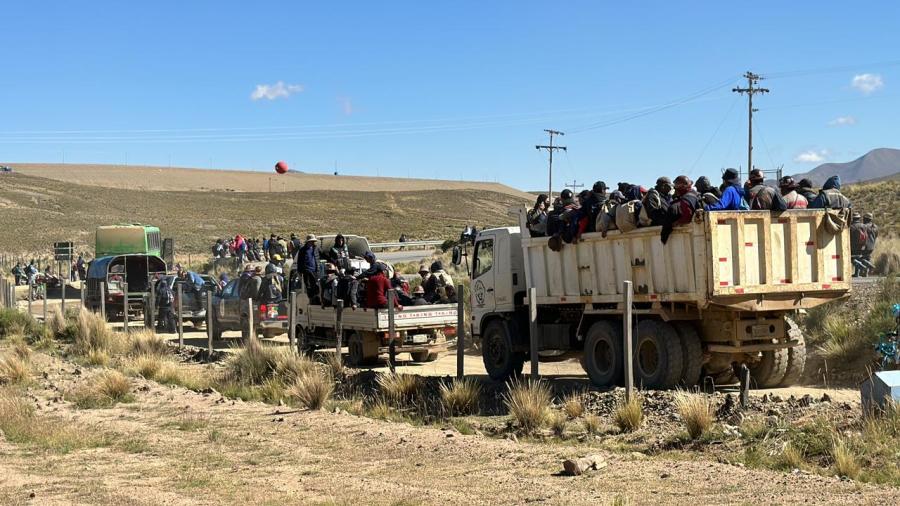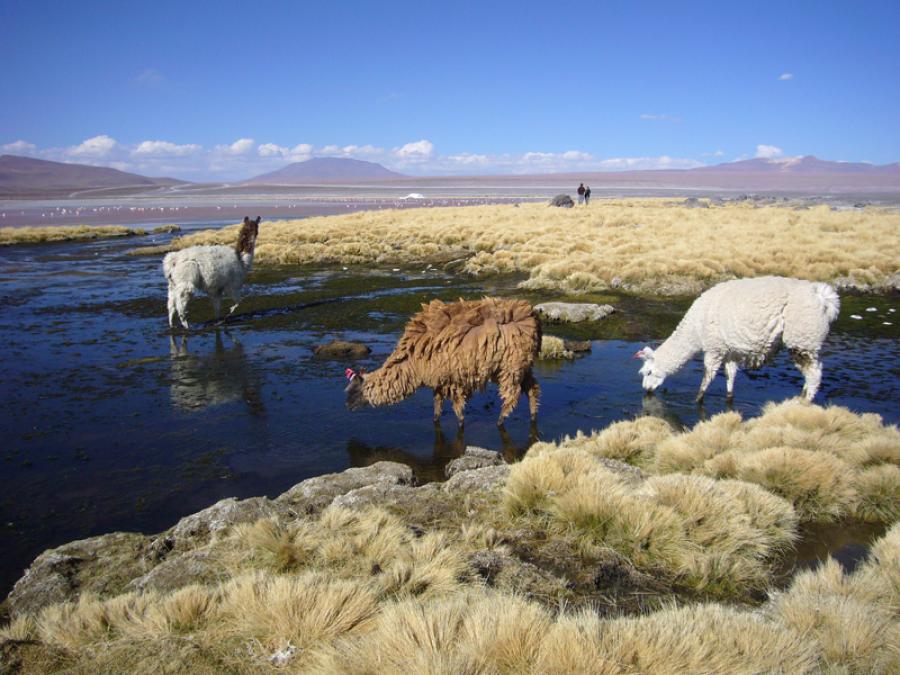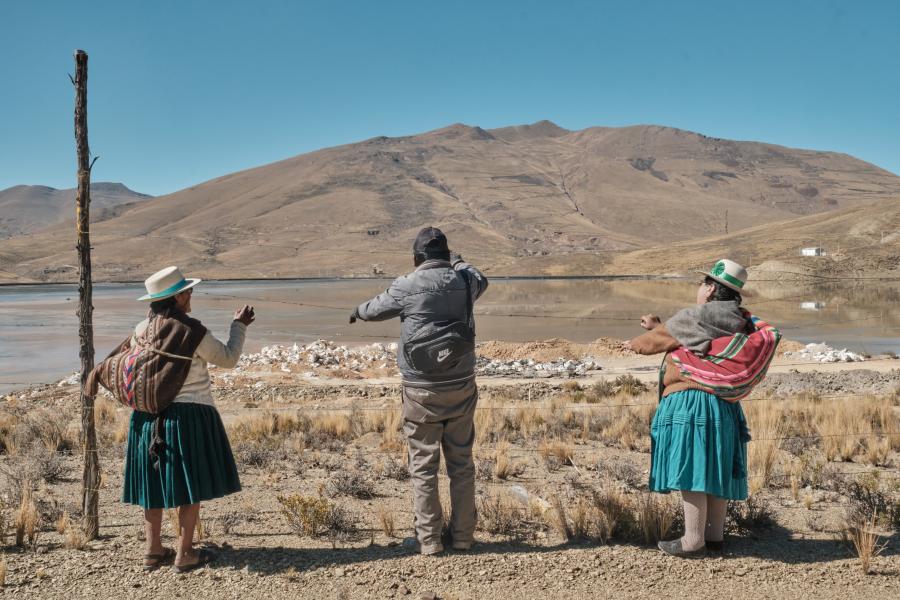In an era of globalization, leaders of "recognized" nations often discuss the development of indigenous resources without inviting aboriginal leaders to the table. Bolivian indigenous activist Ivan Ignacio, one of many indigenous activists at the second People's Summit in Québec City in mid-April, spoke out against the agreement being discussed by 34 heads of state at the Summit of the Americas in another part of Quebec. "We don't know what the [Free Trade Agreement of the Americas] means," he said, "but we know that when the government is doing something behind our backs, it will be bad for us. We know that the FTAA will lead to our deaths. We know that our democracies are corrupt and full of lies; that this industry of democracy produces lies and is manipulated by corporations. Meanwhile, we are left outside the discussion."
The FTAA discussion involves its precedent, the North American Free Trade Agreement (NAFTA) between Mexico, Canada, and the United States. NAFTA is in turn part of the international financial architecture comprised of multinational corporations, nation-states, and institutions like the World Trade Organization (WTO). Through free trade, corporations are able to take advantage of weaker labor markets, diminished tariff barriers, simplified regulatory conditions, and easier resource access to manipulate economic conditions for profit.
Resisting the harmful social and environmental effects of such policies, social movements and activist organizations are increasingly networking across borders. The protests in Québec attracted more than 30,000 activists with diverse interests and representing different regions. They came to protest against the FTAA and to participate in the People's Summit, at which the Americana Indigenismo and environmental forums had indigenous representation from throughout the hemisphere.
Indigenous resistance to economic globalization is essential because neo-liberal policies often impact most heavily on traditional territories and indigenous peoples. Increased market pressures can result in the plunder of lands inhabited by indigenous peoples for thousands of years. Blanca Chancoso, president of the Confederation of Indigenous Nationalities (CONAIE) in Ecuador, reminded the Indigenismo forum that "the resistance of indigenous peoples in the Americas" to plundering elites "is nothing new." Blanca made clear that contemporary global capitalism's harmful effects on indigenous communities have roots in the historical projects of colonialism and imperialism. "In spite of our long struggle," she said, "I can tell you that we have not managed to overcome our exclusion. This struggle continues to be made alone. Today the same policies continue to be perpetrated, all achieving the same consequences for our people."
In Québec, indigenous activists' most poignant and effective resistance methods were testimonials of the collective violence that policies like NAFTA perpetrate on their communities. That their stories were similar is not surprising given that states employ similar racist ideologies, "development" policies, and pacification tactics against indigenous peoples throughout the hemisphere.
Racist Ideologies
Many Western states have justified their domination of indigenous peoples through racist, illogical theories such as terra nullius, by which indigenous lands are considered "unoccupied" and "empty," their inhabitants deemed unable to manage their resources or conceive of property. Under such a policy, colonial and corporate elites, backed by a legal apparatus and scientific methods, are able to purchase and use land that does not belong to them.
Chief Arthur Manuel of the Neskolith band in the southern interior of British Columbia emphasized at the Indigenismo forum that his community's current problems with forestry companies stem from these colonial-era doctrines of discovery: "[These doctrines] said we indigenous peoples had no property interests." Native land thus "accrued" to Europeans, he said.
Arthur noted that this ethnocentric idea "is the essence of usurping and violating the rights of indigenous peoples" today. He cited the Canadian government's Comprehensive Claims Policy, which has as a "primary aim...to extinguish claims to territory" in exchange for limited benefits. Not only is this a "fundamental violation of...human rights," said Arthur, it is also absurd and impossible: "No one has the right and authority to extinguish our relationship to the land."
State (Under)development
As colonial policies are increasingly contested and proved unjustifiable, governments continue to implement "development" projects. In what is now a sadly familiar tale, indigenous communities throughout the Americas are uprooted so that hydroelectric dams can permanently submerge their territories. Forcible eviction into far-off "model villages," and "integration'' into the industrial and urban work force destroy their cultures and result in enduring poverty.
The illusion that development projects are undertaken in their interest faded long ago for indigenous peoples. Kimy Pernia Domico, a traditional leader of the Embera-Katio community in Colombia, watched the Urra Dam flood his community's farming land, destroy fish spawning routes, and create water-borne diseases. Several members of the Embera-Katio community who resisted the dam were killed by government-linked paramilitaries, while the dam company ignored court injunctions and proceeded with construction. To those at the People's Summit who suggested that negotiation with states can be productive, Kimy replied: "You shouldn't consult with governments, but with people who are promoting biodiversity and protecting the land."
Romeo Sanganash, a Cree lawyer and activist who participated in the environmental forum at the People's Summit, agreed. He recounted the long-standing conflict between several thousand Crees in northern Québec and the governments and corporations that have invaded their land and appropriated their resources, most infamously with the construction of the James Bay dam project in the 1970s. At the time, Crees were told that "they had no rights to the land," and were considered by Hydro-Québec and the government to be a "restricting factor" for development. Territory owned and managed by Crees for more than 5,000 years was subjected to mining, forestry, and dam-related flooding; the benefits of industrial activity accrued to southern Canadians. Romeo claimed that Crees are allied with the anti-globalization movement because they share with activists the same goals of achieving sustainable development and human rights protection. He also noted that Cree assertion of self-determination is predicated on their recognition as a self-governing nation fighting their erasure as a people.
Indigenous Pacification and Repression
After violent police-activist clashes at other globalization meetings, the Canadian government's response to activists present at the Summit of the Americas was highly autocratic. The state's military operation involved thousands of armed police and extensive use of tear gas and rubber bullets, eventually leading to hundreds of arrests. The state thus mimicked the grotesque violence enacted through free trade policies by unleashing its power on citizens exercising their right to democratic expression.
The indigenous activists in Québec were already aware that at the numerous sites -- streets, villages, and fields -- where their communities confront globalization, prevailing economic discourse is intimately conjoined with state repression. The imposition of legal and economic frameworks that perpetuate the subjugation of indigenous peoples is intimately bound with state intervention that removes and literally extinguishes them.
Gloria Chicaiza from Acción Ecologíca in Ecuador detailed this combination of state policy and coercion at the environmental forum. She noted that in the last several years the Kosan indigenous peoples of Ecuador have had their land divided and polluted by Texaco, which has, with active government participation, built extensive oil wells on their traditional land. Although Kosan communities were compensated when Texaco released oil into vital waterways, they refused to cooperate when the company's oil spills began desecrating certain sacred rocks and land areas, violating the Kosan spirits residing therein. Gloria noted that the way "the Kosan drew a line at the killing of their spirits" and refused to participate in Texaco's "economic development'' provides an example to all activists who assert the inviolability of environmental, cultural, and political rights and resources.
Global Indigenous Advocacy Networks
To counter state policies of development and pacification, indigenous activists have moved beyond the articulation of dissent and toward the collective assertion of rights and resources by forming powerful advocacy networks both nationally and internationally.
Three indigenous activists from Mexico spoke at a People's Summit press conference, providing insight into this process. Juan Chavez, Maria de Jesus Patrico, and Rogelio Mercado are members of the National Indigenous Congress (NIC) in Mexico, a group similar to Blanco Chancoso's CONAIE in Ecuador and Matthew Coon Come's Assembly of First Nations (AFN) in Canada. Maria noted that the first NIC conference was held in 1996, two years after the Zapatistas began their now-famous uprising in Chiapas. The third meeting (at which most of the 56 indigenous groups in Mexico were represented) was held in March 2001 and coincided with the Zapatista caravan to Mexico City to press the government for constitutional enshrinement of rights for indigenous peoples. The NIC, said Maria, "is a space where we meet to exchange ideas, where indigenous peoples are present -- though still excluded from other political forums -- and where we meet indigenous peoples from other countries." Such indigenous mobilization -- through public education, direct action and protest, and political lobbying -- has elevated indigenous concerns to the public and governmental arenas.
Rodney Bobiwash, an Ojibwa aboriginal activist and official at the Centre for World Indigenous Studies (CWIS) in Toronto, utilizes such national platforms to mobilize indigenous groups across borders. Speaking after the Indigenismo forum, Rodney noted that he constantly communicates with indigenous groups throughout the Americas, and lobbies on their behalf at meetings of the Organization for American States (OAS) and the World Bank. Together with indigenous communities, he attempts to find "common ground on problems," and pushes for a high priority on indigenous rights and concerns when the OAS and World Bank draft new financial and development policies. Indigenous groups can then use these national and international fora and institutional channels as levers with which to maintain control over their own lives when negotiating with local governments and corporations.
Indigenous activests are bearing witness to the effects of globalization: the frustration, pain, and rage accompanying stat-sponsored exclusion, displacement, and violence. Ivan Ignacio noted at the Indigenismo forum that globalization treaties like the FTAA represent for indigenous peoples a "second colonialism." This time, indigenous peoples are becoming a formidable political force, mobilizing on may level -- nationally and internationally -- to create the lasting conditions for control over their collective destiny.
Article copyright Cultural Survival, Inc.



